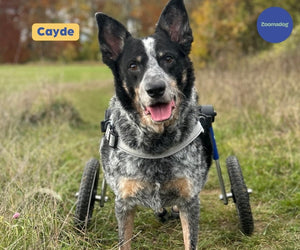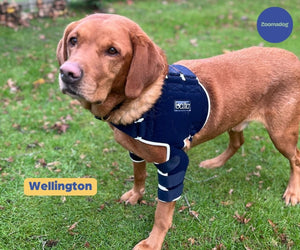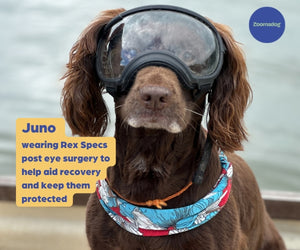01730 622544

Prophylactic X-Rays are Worth Every Penny
By James St Clair Top Dog Health.
An article on why you should have your dog x-rayed if they suffer from hind leg weakness, lameness or other issues of weakness in the rear.
It always amazes me as to how many patients come into my canine rehabilitation facility, TopDog Health Rehabilitation, that were referred from their veterinarian for issues related to hind end weakness. Yet, when I ask the client about whether or not they have had any X-rays taken they sayNO!
How the heck can you treat something if you don€™t know what you are treating? Therefore, the first thing we do at the initial consultation is take X-rays. It is as simple as that! This way we know what we are working with from the start.
Most pet owners and many veterinarians assume that hind end weakness is related to Osteoarthritis of the hip joints and in many cases this is true, but not always.
My First Patient at TopDog:
I distinctly remember my first patient at TopDog. She was an 11-year-old German shepherd, named Kallie. A few days after opening our doors, a middle-aged gentleman came in, and as he began telling me the story of Kallie his eyes began to swell up with tears. Kallie was extremely weak in her hind legs and was unable to get up on her own. His veterinarian told him that she had Degenerative Myelopathy (DM), a common disease found in German Shepherds, and that there was no hope. His family was encouraging him to put her to sleep but he was looking for one last ray of hope. He asked me if I could help. Well, at the time I was just entering into the field of rehabilitation and everything that I knew about DM from school was that there really was no hope. But I figured it was worth a shot. In my simple mind, I rationalized that since DM was a progressive neuromuscular disease, that maybe, just maybe, if I focused on aggressive muscle strengthening that I would be able to potentially stabilize and maybe even reverse some of her muscle loss. He decided to give it a try and the next day Kallie entered into TopDog dragging her hind end on the ground. After 6 sessions of exercise in the underwater treadmill, I remember him coming in and saying that there was no change. He asked me what I thought he should do. My response was, well if it is DM, she is not in any pain, she is otherwise happy; she is eating, drinking, peeing and pooping. Therefore, my suggestion was for us to continue with therapy. Question: How long does it take you to see results when you start going back to the gym and weight lifting?
At the 7th appointment, Kallie came WALKING through the door. It was a miracle! Of course, Kallie never had any x-rays from her primary veterinarian, so I brought Kallie back to my hospital and x-rayed her from head to toe. Guess what? It was not DM at all. She had horrible arthritis in both of her knees and due to chronic pain overtime, she lost muscle progressively in her hind-legs until she did not even have enough strength to get herself up. From that day forward, I learned my lessonto take x-rays right away! Kallie continued on until the ripe old age of 14. She continued coming to TopDog every week and was our first poster child. She was an awesome dog and I miss her dearly.
Two Dogs, One Misdiagnosed Problem:
The saga continues. Fast-forward now eight years. I recently have had a run of older patients i.e. 12-15 year olds who come to TopDog for the typical hind-end weakness. However, the minute they walked through the door it was blatantly obvious to me that there was far more going on. Though they were weak in the hind legs, the problem really in both cases was, in the dogs€™ neck. I will explain this later. Both of these dogs also had been slowly declining for years. And of course, guess what? Neither of them had any recent x-rays. Yet both of them had been prescribed non-steroidal anti-inflammatory (NSAIDs) such as Deramaxx, Rimadyl, Metacam, Previcox, etc. and not any real pain medications.
Do you See Where I Am Going With This?
Here is my point. When it comes to orthopedic disease, x-rays are King! Right? I mean there is really no better way to image bone changes than by taking an x-ray. It is also the most affordable option when it comes to diagnostic imaging when compared to a CT scan or MRI.
With that being said, sometimes you need to take your dog's health into your own hands. If your veterinarian never recommends x-rays then you need be an informed pet owner and request them. The best advocate for your dogs€™ health is you at the end of the day.
Depending on the breed, size or genetic background of your dog, you should strongly consider having x-rays taken multiple times throughout their life and not wait until they are showing signs of weakness or limping. As I have written about before and also discussed in the video. The 12 Subtle Signs of Arthritis, both pet owners and even veterinarians many times miss the early warning signs therefore treatment usually begins way too late in the disease process.
The X-ray Life Plan:
So, here is what I suggest. First, when your dog gets spayed or neutered ask the veterinarian to take an x-ray of their hips. This will give you at least some kind of baseline to go off of. Now, considering that most dogs are spayed or neutered at or around 6 months of age, when they are not fully-grown, the x-rays will not be 100% accurate. But if the hips are bad, your veterinarian will know or at least make a note in their medical file to watch this. If this is the case, then your veterinarian may want to repeat the x-rays at 15 months just to confirm the findings once the dog is full grown.
Secondly, throughout your dogs life, most likely they will need to go under anesthesia or sedation for some kind of procedure. More often than not this is a routine dental cleaning. When this happens, have your veterinarian take another x-ray of the hips. This will allow them to see if there have been any changes over time.
Note: If your dog is over the age of 7 at the time, I also recommend taking an x-ray of the lumbar spine. Let me briefly explain why. When dogs are referred to me for hind-end weakness, again it is believed that the problem is in the hips, but many times this is not the case. Many times the hips are great but the problem is actually at the lumbosacral junction. This is the point in the spine just in front of the pelvis. Because this is a pivot point for the hind legs, it undergoes a lot of stress throughout the dog's life, from running and jumping. This is very similar to people with lower back problems. This spinal arthritis is very painful and presents visibly the same as a dog with hip arthritis. In addition, the treatment protocol is often very different for this kind of arthritis.
Bringing it all together:
The reason that this concept of prophylactic x-rays is so important is simply for planning and preventative reasons. The earlier you start to address the problem the better and many times the only way to know if there is a problem is via seeing it with X-rays.
Two Happy Dogs.
By the way, the two dogs with hind-leg weakness, which recently came to TopDog. Both of them had cervical disk disease, meaning they had problems in their spinal cord being compressed in their neck region. These dogs developed this condition secondary to the fact that they had horrible arthritis in their hips (undiagnosed for years mind you) and because their hips hurt them so much they were compensating by shifting all of their weight to the front end. Overtime this compensation led to a breakdown of their intervertebral disks in their neck. Due to their age and chronic nature of their disease, I began medical treatment on them, incorporating steroid therapy and aggressive pain management. We also took a very aggressive approach toward their joint health with supplements developed at TopDog and began physical rehabilitation. Both are doing AMAZING and have a new lease on life.

Looking for help with your dog?
We can help find the right solution for your dog
Feel free to give us a call on 01730 622544
or email us at woof@zoomadog.co.uk







Leave a comment